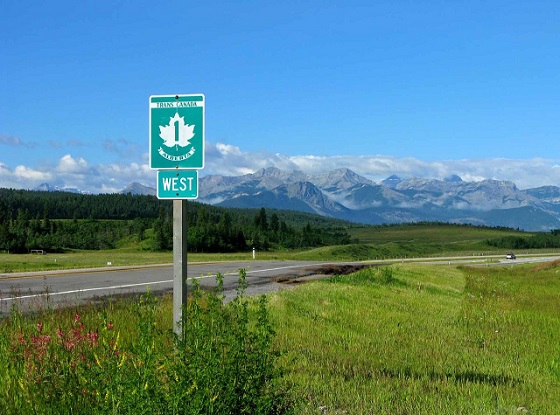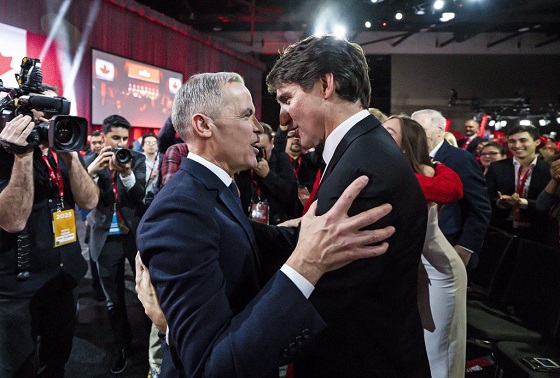Alberta
Scotia Place – Calgary unveils design for new arena / events centre

News release from the City of Calgary
Scotia Place, Calgary’s new event centre, designed as a place for community where there is room for everyone
The City of Calgary and Calgary Sports and Entertainment Corporation (CSEC) are excited to reveal the design for Calgary’s new event centre – formally named Scotia Place.
The design is influenced by the ancestral and historical land of Indigenous Peoples and the culturally significant site that embodies our shared purpose – to gather. It brings together Indigenous cultural perspectives with Calgary’s and the region’s natural beauty, reflecting the four elements of nature – fire, ice, land and air.
A striking feature of the building is the central structure with a textured flame motif that emulates a home fire, which is further amplified when it is lit at night. The home fire, a place of warmth and energy that brings people together to share stories of the past and create stories for the future, rises from the white, glacial-like forms that define the lower parts of the building.
“When you consider that Calgary is already the envy of other cities with a new world-class convention centre in the heart of the Culture + Entertainment District, the addition of Scotia Place is another signal to investors that our city understands how to build a future that leverages hospitality and hosting as its core strengths,” says Mayor Jyoti Gondek. “We are also acknowledging and honouring the foundational role that Indigenous communities have played for generations in making Calgary, and now Scotia Place, a space where we all belong.”
Scotia Place, which is scheduled to open in fall 2027, celebrates the area’s importance as a place for all and will be a landmark attraction in Calgary’s emerging Culture + Entertainment District. More than a building, however, the 10-acre city block is designed for community and connection and includes a community rink, outdoor and indoor plazas spaces, four restaurants, the Calgary Flames Team Store, and future development opportunity in the northeast corner. It will provide gathering places and amenities for the 8,000 people who will live in this new downtown neighbourhood.
“Calgary has a long history of hosting world-class events, drawing millions of visitors to the city each year, generating revenue for local businesses, and boosting the economy,” says Danielle Smith, Premier of the Province of Alberta. “With construction on the Calgary Rivers District and Event Centre now underway, Calgary is one step closer to a revitalized downtown that will bring new energy into the city, attract more exciting events, and create jobs to improve the quality of life for Calgarians.”
A development permit application for the facility was submitted on July 19, 2024. This was a significant milestone for the project team, consisting of CAA ICON, HOK-DIALOG, and CANA/Mortenson. People interested in following or commenting on the permit can find the application at Calgary.ca/dmap. The application is expected to be heard by the Calgary Planning Commission by end of 2024.
“This is an important day for Calgary,” says Councillor Sonya Sharp, Event Centre Committee Chair. “Today is about so much more than the designs of a building. Today is the unveiling of a place where Calgarians and visitors from around the world will make memories at concerts, and sport and community events. I hope that everyone is as excited as we are, knowing that Scotia Place will become the complete experience in our new Culture & Entertainment District.”
“At CSEC, a key component of our mission is to be the heartbeat of our community, create connections and bring people together,” said Robert Hayes, CSEC President and CEO. “Scotia Place will become the perfect home to achieve and share this mission with all Calgarians. Seeing the design brings the vision of so many contributors to life. We are especially thankful to the City of Calgary and the Province of Alberta for their leadership and support to help bring us to this point. In stride with our partner Scotiabank, we are very proud to play our role in presenting Scotia Place as the culmination of diligence and passion, that is now visual in this breathtakingly beautiful and meaningful facility.”
“For years we have seen firsthand the value these partnerships bring to the communities in which we operate and for our clients,” said Aris Bogdaneris, Group Head, Canadian Banking of Scotiabank. “Scotia Place introduces a bold new vision for what will be Alberta’s premier sports and entertainment venue. For nearly 20 years, Scotiabank has been a proud partner of Calgary Sports and Entertainment Corporation and together, we are committed to bring fans and our clients an unforgettable experience when they walk through the doors of Scotia Place.”
“We are excited to start the construction of the critical infrastructure needed to build thousands of new homes and to make the Calgary’s new Culture + Entertainment district a reality,” says Devin Dreeshen, Minister of Transportation and Economic Corridors. “Albertans expect basic infrastructure to be maintained and improved and this commitment from the province goes a long way in helping Calgary build these projects.”
Acknowledging the significance of the building’s location at the confluence of the Bow and Elbow Rivers on the ancestral land of the Treaty 7 Peoples and the Metis Nation, The City, CSEC, HOK-DIALOG and CAA ICON worked with an Indigenous Advisory Group that included representatives from the Treaty 7 Nations, the Métis Nation of Alberta, Region 3, and the Urban Indigenous community throughout the design process.
“It was great to be part of a truly representative voice that included all indigenous peoples of southern Alberta regarding the design of this center acknowledging the historic significance of the land it sits on to the Metis people,” said Carmen Lasante Captain of the Calgary Elbow Metis District. “Inclusivity is a core part of who the Metis are. The City has worked hard to include many diverse histories together in creating this space.”
“Engaging in the right way is fundamental to the success of relationship development with the Indigenous communities, as we have played a critical role in the identity of the land now known as the city of Calgary as the Indigenous nations are inextricable linked to the landscape and environment,” says Ira Provost, Piikani Nation Consultation
A key theme heard often during the Indigenous engagement sessions was “Come in, there is room”, making it clear that Scotia Place needs to be a place that is designed for all.
The public plazas are designed to honour the deep-rooted connection that Indigenous Peoples have with the land, incorporating representations of the tipi, Métis Trapper’s Tent, and elements of Alberta’s world-renown natural landscape.
An important design decision was to lower the event and ice surface so that the primary concourse will be at street-level. Calgarians and visitors will be able to move seamlessly between the curb, the primary concourse and the outdoor public plazas.
“We at DIALOG are thrilled to join forces with HOK and combine our unique expertise to transform Calgary’s Event Centre into the catalyst for a dynamic new urban community,” says Doug Cinnamon, Partner Architect at DIALOG.
“Other design principles including public realm activation, the integration of indigenous influences, public art & storytelling, sustainability, and a balance between past, present, and future is central to our vision. The ultimate goal is to ensure seamless accessibility, promote mixed uses, and create vibrant public areas for everyone to enjoy. This joint redesign represents an opportunity to spur investment into the area and enhance its cultural vitality, anchoring Calgary’s position as a thriving, bustling community hub.”
Scotia Place is a generational investment in Calgary’s emerging vibrant Culture + Entertainment District. A modern event centre with universal accessible design throughout and with energy and water conservation built in to maximize efficiencies and the ability to be net-zero by 2050, Scotia place is designed to serve Calgary’s growing community for decades to come.
Construction begins this week. Additional information about Scotia Place including design renderings, a video, and frequently asked questions is available on Calgary.ca/ScotiaPlace.
Alberta
Tell the Province what you think about 120 km/h speed limit on divided highways

Alberta’s government is engaging with Albertans on increasing speed limits on rural highways.
Starting Nov. 7, Albertans can share their views on modernizing speed limits on divided highways through an online survey running until Dec. 12. The survey will ask how Albertans view raising the speed limit by 10 km/h on various highways from 110 km/h to 120 km/h.
“Alberta’s government is investigating how to safely increase speed limits on divided highways, and if Albertans support increasing speed limits. We are investing more than $1.5 billion this year alone to improve highway safety and upgrade infrastructure across the province. We want Albertans to be able to drive the speed limit that the highways are designed for. Modern vehicles combined with public awareness mean we can explore higher speed limits.”
The survey will provide Albertans with the opportunity to provide input on which highways they would prioritize having a speed limit increase, their views on restricting commercial trucks from using the far-left lane on highways with three or more lanes and any other feedback that would improve driving experiences on provincial highways.
Following a review of the survey results, Alberta’s government plans to conduct a mini-trial of a 120 km/h speed limit to assess the impacts of higher speed limits on divided highways. The trial will include strong monitoring to assess driving behaviour.
Alberta’s government reminds motorists to slow down and drive to the conditions. Speed limits are set for ideal conditions. When roads are wet, icy or when there is reduced visibility, motorists should slow down.
Quick facts
- Alberta’s provincial highway network includes more than 64,000 lane kilometres of highways, about 11,700 lane kilometres of which are divided.
- The posted speed limits of Alberta’s divided highways range from 100 to 110 km/h, although the posted speed limits on segments passing through cities, towns and First Nation lands can be as low as 50 km/h due to factors such as signalized intersections, pedestrians and local access.
Related information
- The survey is available online.
Alberta
Alberta Announces Members of Class Size and Complexity Committee

A new Class Size and Complexity Cabinet Committee has been struck to address classroom challenges.
Taking action on class size and complexity
Classrooms in Alberta continue to grow and are becoming increasingly complex, and immediate action is needed to address these issues in the public education system. To meet these issues head on, the Class Size and Complexity Cabinet Committee has been created. The cabinet committee will help guide government policy and deploy resources to deal with class sizes and classroom complexity.
“We are committed to providing world-class education, and we’re building schools and funding education at a rate unprecedented in this province. This committee will help us address the concerns of teachers, parents and students around class sizes and complexity.”
Throughout November, Alberta’s government will continue work with school boards to collect data on class sizes and classroom composition. The cabinet committee will use this data to direct resources to the classrooms that need it the most. Starting in January, this data will be made available and released annually.
The Class Size and Complexity Cabinet Committee will be co-chaired by the Premier of Alberta and the Minister of Education and Childcare. It will also include non-voting members representing school boards, administrators and a teacher representative of the ATA. The committee will also hear from school boards, academic experts, teachers, educational assistants, complex needs specialists and parents to inform its decisions and guide this vital work.
“We heard teacher concerns, and we are providing solutions. The Class Size and Complexity Cabinet Committee will help us take immediate action and ensure teachers and students are given the support they need to succeed.”
In June 2025, Alberta’s government established the Aggression and Complexity in Schools Action Team to provide advice on addressing classroom complexity. The report has been received and will be released soon. Over the coming months, the cabinet committee will start rolling out solutions informed by the action team’s recommendations. In addition, the committee will guide the creation of a new inclusive education policy framework.
“The work of this committee will support teachers in responding to the growing complexity in our classrooms. We will ensure that the voices of the contributors to the initial work guide
solutions that truly improve the educational experience for students and the educators who serve them.”
“I appreciate the government’s recognition of the impact of classroom complexity and their commitment to working collaboratively for improvement. Supporting teachers ultimately improves classroom conditions and student outcomes.”
Using data collected, this cabinet committee will also guide Alberta’s government in executing its commitment to hire 3,000 new teachers and 1,500 new educational assistants over the next three years. They will also assist in identifying and prioritizing where new schools and modulars should be built, advancing the government’s commitment to invest $8.6 billion to build 130 new schools, and provide 109 modular classrooms in the growing communities that need them urgently.
Quick facts
- Members of the Class Size and Complexity Cabinet Committee include:
- Danielle Smith, Premier of Alberta
- Demetrios Nicolaides, Minister of Education and Childcare
- Jason Nixon, Minister of Assisted Living and Social Services
- Rick Wilson, Minister of Mental Health and Addiction
- Searle Turton, Minister of Child and Family Services
- Lynnette Anderson, chief superintendent, Edmonton Catholic Schools
- Nicole Buchanan, chair, Red Deer Public Schools
- Marilyn Dennis, former president of Alberta School Boards Association
- Mike McMann, superintendent, Fort Vermilion Schools and President, College of Alberta School Superintendents
- Joanne Pitman, chief superintendent, Calgary Board of Education
- Dr. Elissa Corsi, Alberta Teachers’ Association
- Only Cabinet members are voting members. Additional guests will be invited to attend and share their expertise at the discretion of the chairs.
- School boards will be required to submit data on Alberta classrooms by Nov. 24.
-

 Business2 days ago
Business2 days agoCarney budget doubles down on Trudeau-era policies
-

 espionage2 days ago
espionage2 days agoU.S. Charges Three More Chinese Scholars in Wuhan Bio-Smuggling Case, Citing Pattern of Foreign Exploitation in American Research Labs
-

 COVID-192 days ago
COVID-192 days agoCrown still working to put Lich and Barber in jail
-

 Business1 day ago
Business1 day agoCarney’s Deficit Numbers Deserve Scrutiny After Trudeau’s Forecasting Failures
-

 Business2 days ago
Business2 days agoCarney budget continues misguided ‘Build Canada Homes’ approach
-

 International1 day ago
International1 day agoKazakhstan joins Abraham Accords, Trump says more nations lining up for peace
-

 armed forces20 hours ago
armed forces20 hours agoIt’s time for Canada to remember, the heroes of Kapyong
-

 Business2 days ago
Business2 days agoHere’s what pundits and analysts get wrong about the Carney government’s first budget







